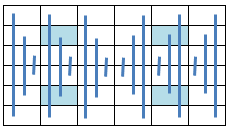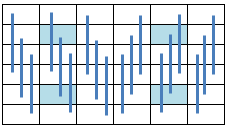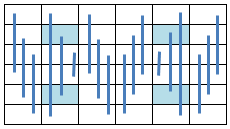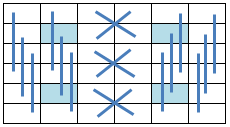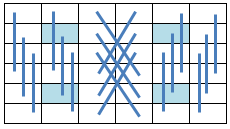Office Applications and Entertainment, Magic Squares | ||
|
|
Index | About the Author |
|
14.0 Special Magic Squares, Prime Numbers
14.4.20 Symmetric Magic Squares (6 x 6)
In previous sections following possible symmetries have been introduced:
and applied in combination with other properties.
14.4.21 Axial Symmetric Pan Magic Squares
When the equations defining the Axial Symmetry as illustrated below:
a(31) = s1 - a(32) - a(33) - a(34) - a(35) - a(36) a(25) = s1 - a(26) - a(27) - a(28) - a(29) - a(30) a(24) = - s1/2 + a(26) + a(27) + a(28) + a(33) a(23) = s1/2 - a(28) - a(29) - a(30) + a(32) a(22) = 3*s1/2 - a(27) - a(28) - a(29) - a(32) - a(33) - a(34) - a(35) - a(36) a(21) = s1/2 - a(26) - a(27) - a(28) + a(36) a(20) = - s1/2 + a(28) + a(29) + a(30) + a(35) a(19) = - s1/2 + a(27) + a(28) + a(29) + a(34)
which can be incorporated in a routine to generate subject Axial Symmetric Pan Magic Squares
(ref. MgcSqr6122).
14.4.22 Row Symmetric Pan Magic Squares (Type 1)
When the equations defining the Row Symmetry as illustrated below:
a(31) = s1 - a(32) - a(33) - a(34) - a(35) - a(36) a(23) = - a(24) + a(35) + a(36) a(22) = a(24) + a(34) - a(36) a(21) = - a(24) + a(33) + a(36) a(20) = a(24) + a(32) - a(36) a(19) = s1 - a(24) - a(32) - a(33) - a(34) - a(35) a(12) = s1/2 - a(24) - a(32) - a(34) + a(36) a(11) = -s1/2 + a(24) + a(32) + a(34) + a(35) a(10) = s1/2 - a(24) - a(32) a(9) = -s1/2 + a(24) + a(32) + a(33) + a(34) a(8) = s1/2 - a(24) - a(34) a(7) = s1/2 + a(24) - a(33) - a(35) - a(36)
which can be incorporated in a routine to generate subject Row Symmetric Pan Magic Squares
(MgcSqr6123).
14.4.23 Row Symmetric Pan Magic Squares (Type 2)
When the equations defining the Row Symmetry as illustrated below:
a(31) = s1 - a(32) - a(33) - a(34) - a(35) - a(36) a(27) = 2*s1 - 2 * a(28) - 2 * a(29) - a(30) - a(33) - 2 * a(34) - 2 * a(35) - a(36) a(26) = -2*s1 + 2 * a(28) + 3 * a(29) + 2 * a(30) - a(32) + 2 * a(34) + 3 * a(35) + 2 * a(36) a(25) = s1 - a(28) - 2 * a(29) - 2 * a(30) + a(32) + a(33) - a(35) - a(36) a(22) = - s1/2 - a(23) - a(24) + a(28) + a(29) + a(30) - a(32) + a(34) + 2 * a(35) + a(36) a(21) = s1 + a(24) - 2 * a(28) - 2 * a(29) - 2 * a(30) + 2 * a(32) + a(33) - 2 * a(35) - a(36) a(20) = - s1 + a(23) + 2 * a(28) + 2 * a(29) + 2 * a(30) - a(32) + a(35) a(19) = 3*s1/2 - a(23) - a(24) - a(28) - a(29) - a(30) - a(33) - a(34) - a(35)
which can be incorporated in a routine to generate subject Row Symmetric Pan Magic Squares
(MgcSqr6124).
14.4.24 Crosswise Symmetric Pan Magic Squares
When the equations defining the Crosswise Symmetry as illustrated below:
a(31) = s1 - a(32) - a(33) - a(34) - a(35) - a(36) a(22) = - a(23) + a(33) + a(36) a(20) = s1 - a(21) - a(32) - a(33) - a(35) - a(36) a(19) = - a(24) + a(32) + a(35) a(12) = s1/2 + a(23) - a(32) - a(33) - a(36) a(11) = s1/2 + a(24) - a(32) - a(33) - a(35) a(10) = -s1/2 + a(21) + a(32) + a(33) + a(35) a( 9) = -s1/2 - a(23) + a(32) + a(33) + a(34) + a(35) + a(36) a( 8) = s1/2 - a(24) - a(34) a( 7) = s1/2 - a(21) - a(35)
which can be incorporated in a routine to generate subject Crosswise Symmetric Pan Magic Squares
(MgcSqr6125).
14.4.25 Symmetric Pan Magic Squares (Type 4)
When the equations defining the assorted symmetry as illustrated below:
a(31) = s1 - a(32) - a(33) - a(34) - a(35) - a(36) a(27) = 3*s1/2 - a(28) - a(29) - a(32) - a(33) - 2 * a(34) - a(35) - a(36) a(26) = -s1 + a(29) + a(32) + 2 * a(34) + a(35) + 2 * a(36) a(25) = s1/2 - a(29) - a(30) + a(33) - a(36) a(23) = s1/2 - a(28) - a(29) - a(30) + a(32) a(22) = - a(24) + a(34) + a(36) a(21) = a(24) + a(33) - a(36) a(20) = -s1/2 + a(28) + a(29) + a(30) + a(35) a(19) = s1 - a(24) - a(32) - a(33) - a(34) - a(35)
which can be incorporated in a routine to generate subject Symmetric Pan Magic Squares
(MgcSqr6127).
14.4.26 Symmetric Magic Squares (Type 3)
When the equations defining the assorted symmetry as illustrated below:
a(31) = s1 - a(32) - a(33) - a(34) - a(35) - a(36) a(26) = 2 * s1/3 - a(29) - a(32) - a(35) a(19) = s1 - a(20) - a(21) - a(22) - a(23) - a(24) a(12) = 2 * s1/3 + a(21) - a(22) - 2 * a(29) + a(31) - a(32) - a(35) a(9) = s1 - a(10) - a(31) - a(32) - a(35) - a(36) a(7) = -2 * s1/3 - a(21) + a(22) + 2 * a(29) + a(32) + a(35) + a(36)
which can be incorporated in a routine to generate subject Symmetric Magic Squares
(MgcSqr6116).
14.4.27 Symmetric Magic Squares (Type 5)
When the equations defining the assorted symmetry as illustrated below:
a(31) = s1 - a(32) - a(33) - a(34) - a(35) - a(36) a(25) = 4*s1/3 - a(26) - a(29) - a(30) - a(31) - a(32) - a(35) - a(36) a(24) = a(26) - a(29) + a(31) a(21) = s1 - a(22) - a(31) - a(32) - a(35) - a(36) a(20) = - a(23) + a(32) + a(35) a(19) = - a(26) + a(29) + a(36) a(10) = (2*s1 - 2 * a(22) - 2 * a(31) - 2 * a(32) + a(33) - a(34) - 2*a(35) - 2*a(36))/2 a( 9) = s1 - a(10) - a(31) - a(32) - a(35) - a(36)
which can be incorporated in a routine to generate subject Symmetric Magic Squares
(MgcSqr6118).
14.4.28 Symmetric Magic Squares (Type 6)
When the equations defining the assorted symmetry as illustrated below:
a(31) = s1 - a(32) - a(33) - a(34) - a(35) - a(36) a(25) = s1 - a(26) - a(27) - a(28) - a(29) - a(30) a(22) = -s1 + a(24) - a(26) + a(27) - a(28) + a(29) + a(32) + 3 * a(33) + a(35) + a(36) a(21) = -s1 + a(24) - a(26) + a(29) + a(32) + 2 * a(33) + a(34) + a(35) + a(36) a(20) = - 4 * a(21) - a(23) - 2 * a(27) + 2 * a(28) + a(32) + 4 * a(34) + a(35) a(19) = -s1 + a(24) - 2 * a(26) + a(27) - a(28) + 2 * a(29) + a(32) + 3 * a(33) - a(34) + a(35) + 2*a(36)
which can be incorporated in a routine to generate subject Symmetric Magic Squares
(MgcSqr6119).
The obtained results regarding the miscellaneous types of order 6 Prime Number Symmetric Magic Squares as deducted and discussed in previous sections are summarized in following table: |
Type
Characteristics
Subroutine
Results
Pan Magic
Axial Symmetric
Row Symmetric, Type 1
Row Symmetric, Type 2
Crosswise Symmetric
Mixed Symmetric, Type 4
Simple
Mixed Symmetric, Type 3
Mixed Symmetric, Type 5
Mixed Symmetric, Type 6
|
Comparable routines as listed above, can be used to generate Prime Number Rectangular Compact Magic Squares of order 6, which will be described in
Section 14.4.30.
|
|
|
Index | About the Author |
